
Artemisia was a female Italian Baroque painter born on July 8th 1593. She was the eldest child of Prudenzia di Ottaviano Montoni and the Tuscan painter Orazio Gentileschi. Her mother died in 1605 and Artemisia at 11 years of age was then raised primarily by her father Orazio. It is speculated that it was at this time when Artemisia was introduced to painting by spending time in her fathers workshop. She showed much more enthusiasm and talent then her brothers who were already working along side their father.
Artemisia learned drawing, how to mix colour and how to paint during this time. Her father was so proud, he boasted to anyone who was within listening distance that Artemisia, despite having only practiced for 3 years was peerless. He was proud that she took inspiration from his painting style that which had been heavily influenced by the work of Caravaggio. There where however differences between Artemisia’s style of highly naturalistic works and her fathers more idealised works.
The earliest surviving works we know of was completed by Artemisia by the age of 17 named Susanna and the Elders ( 1610 )

During the year that Artemisia was 17 her father rented the upstairs apartment to a female tenant, Tuzia. She became close with Tuzia as she was one of the few females in her life after the death of her mother. One could even say that Artemisia thought of Tuzia as a close friend.
In 1611 a year after Susanna and the Elders was completed her father Orazio was working with Agostino Tassi to decorate the vaults of Casino delle Muse inside the Palazzo Pallavicini- Rospigliosi in Rome. One day in May Tassi went to visit the house of Orazio and when he was alone with Artemisia he raped her along with the help of another man Cosimo Quorli who played a part in the rape.
Tuzia was there as well and even though Artemisia called to Tuzia for help, Tuzia simply ignored her and denied publicly that it ever happened. Shame on Tuzia! I don’t know why Tuzia turned against her maybe she was scared or maybe she just didn’t care but geez what a slap in the face for Artemisia.
Poor Artemisia it was different times back then and if the man who raped a woman married her to restore her ” virtue and secure her future” no charges would be pressed against him and she could live a life without being shunned from society and degraded. How awful right? You had to marry your rapist to restore you’r virtue. ( Ugh! How disgusting, poor her. )
Well needless to say of course Tassi promised to marry Artemisia to avoid charges and she began to have sexual relations with him. Nine months after the rape her father found out that Tassi had no intentions of marrying his daughter at all and he discovered that Tassi was stealing paintings from his families home, so Orazio decided to press charges against him. Good Job Orazio!!!
The trial lasted 7 months and the information that came out during the trail was straight out of a murder mystery novel. It was discovered that Tassi was indeed already married and had planned to murder his wife. He had also had an affair with his sister-in-law and was planning to steal more of Orazio’s painting’s. During the trial Artemisia was tortured with thumb screws for the purpose of verifying her testimony. In the end of the trial Tassi was found guilty and exiled from Rome, although they never followed through with the exiling.
A month after the trial her father arranged for her to marry Pierantonio Stiattesi, a modest artist from Florence. Artemisia would spend the next 6 years in Florence becoming a successful court painter , enjoying the patronage of the House of Medici all the while playing a significant role in courtly culture of the city. She became the first woman accepted into the Accademia della Arti del Disegno.
She was able to maintain good friendships with respected artists at that time. This was very important because it gave her protection from influential people such as Cosimo de Medici and the Grand Duchess, Christina of Lorraine. All this gave her access to patrons and widened her education and exposure to the arts. Artemisia learned to read and write and was exposed to theatrical performances.
In 1613 Artemisia painted Judith and her Maidservant

In 1615 she painted Self Portrait as a Female Martyr

In 1615 she received the attention of Michelangelo Buonarroti the Younger. He was busy with the construction of the casa Buonarroti to celebrate his great uncle so he asked Artemisia and other Florentine artists such as Agostino Ciampelli, Sigismonda Coccapani, Giovan Battista Guidoni and Zanobi Rosi to contribute to the ceiling. Each artist was commissioned to present an allegory of a virtue associated with Michelangelo. Artemisia was assigned the virtue of Allegory of Inclination.
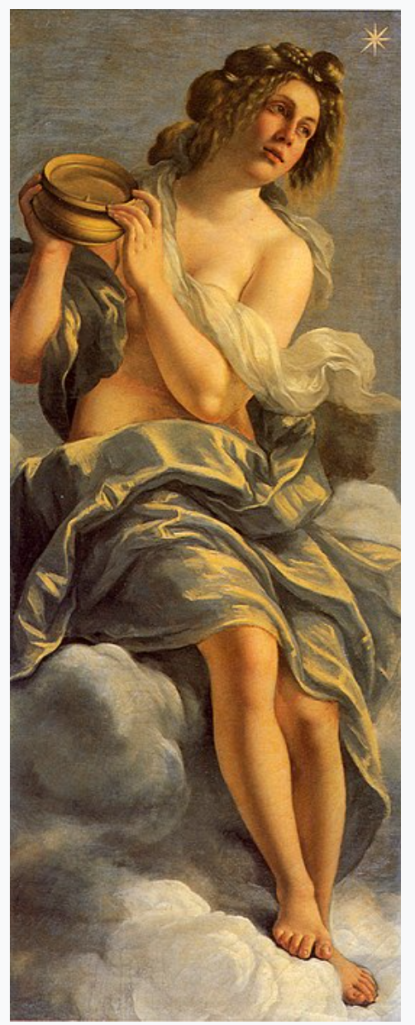
At this time Artemisia was well into the last months of her pregnancy. In this instance she was paid three times more than any other artists participating in the series. It was something that was unheard of in these times and was quiet an accomplishment for her.
During this time she also painted Self portrait as a Lute Player in 1615

Self Portrait as Saint Catherine of Alexandria in 1619

The second version of The Beheading Holofernes 1613
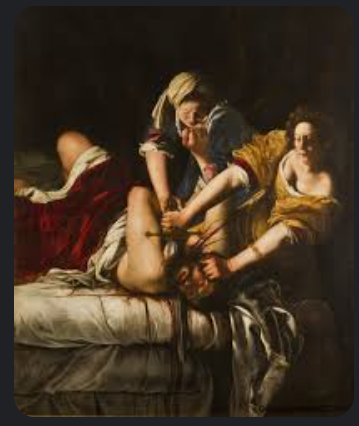
While in Florence Artemisia and Pierantonio had five children. Two of their children Giovanni and Lisabella did not survive for more than a year. Their second son Cristofano died at the age of around 5. Only one of their five children Prudentia survived into adulthood.
Francesco Solina’s discovered a collection of 36 letters dating from 1616 to 1620. These letters add some startling context to the personal and family life of Artemisia. These letters show that she had a passionate affair with a wealthy Florentine nobleman named Francesco Maria Maringhi. Unbelievably her husband Pierantonio was well aware of the affair and maintained a correspondence with Maringhi on the back of Artemisia’s love letters.
It is believed that because Maringhi was such a powerful ally who provided the couple with financial support that her husband may have even supported the affair. Can you imagine? But as the gossip and rumors of their affair spread through the Florentine court they decided to relocate to Rome.
In 1629 Cleopatra
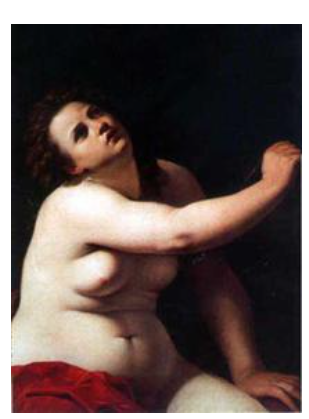
In 1622 Portrait of a Condottiero
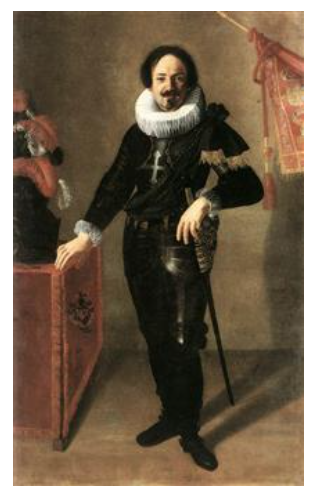
In 1624 Judith and Her Maidservant with the Head of Holofernes
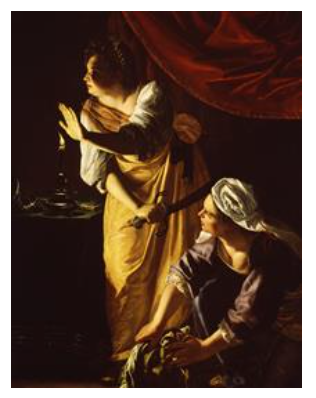
In 1627 she painted Aurora

In the early 1629’s just as they arrived in Rome her father departed for Genoa, her contact with her lover Maringhi lessened and by 1623 any mention of her husband disappears from any surviving documentation. Yet Artemisia had new opportunities there in Rome. Her career quickly took off and her money problems eased. Fernando Afan de Ribera the 3rd Duke of Alcala added her painting of the Mary Magdalene to his collection.

During this same time she became associated with Cassiano dal Pozzo a humanist and collector of arts. Dal Pozzo helped her to form relationships with other artists and patrons and her reputation grew. Pierre Dumonstier II produced a black and red chalk drawing of her right hand in 1625.
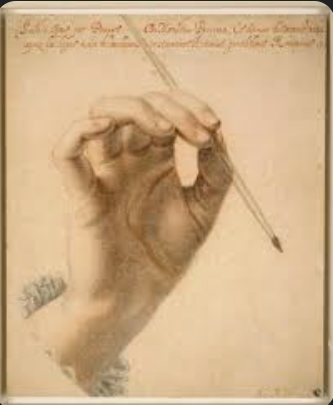
An absence of documents makes it hard to follow Artemisia’s movements in the late 1620’s, but we do know that between 1626 and 1627 she moved to Venice. It is believed that in this time she produced The Sleeping Venus
The Sleeping Venus

As well as her Esther and Ahasuerus.

In 1639 Artemisia moved to Naples in search of new job opportunities. She was already known in Naples before her arrival. She started working on paintings and produced the Birth of Saint John the Baptists

Then she produced the paining Corisca and the Satyr

In 1638 Artemisia joined her father in London at the court of Charles I of England. Where her father Orazio had become court painter. The two of them began working together once again. During this time Artemisia caught the attention of Charles I and he invited her to his court. He was a known art lover and he spent alot of money on his art pieces. So much so that he faced criticism for it. One of her pieces he had in his collection was the Self Portrait as the Allegory of Painting.

In 1639 her father Orazio died suddenly and in 1642 Artemisia left England. Nothing is known about her movements until 1649 when she returned to Naples again. She was corresponding with Don Antonio Ruffo of Sicily who became her mentor. Then again we lost her until 1656 when a devastating plague swept through Naples and virtually wiped out an entire generation of artists including Artemisia.
The most recent critics have said that Artemisia was a artist who fought with determination- using the weapon of personality and of artistic qualities- against prejudices expressed against women painters.
If you want further reading about Artemisia I have included some below.
- Barker Sheila ( 2017 ) Artemisia Gentileschi in changing light, Harvey Miller Publishers.
- Greer, Germaine (1979 )The Obstacle Race: The Fortunes of Women Painters and Their Work.
Thank you for reading my post of Featured Artists of the week. Until next time stay inspired and blessed. Please feel free to like comment and subscribe.

Leave a comment